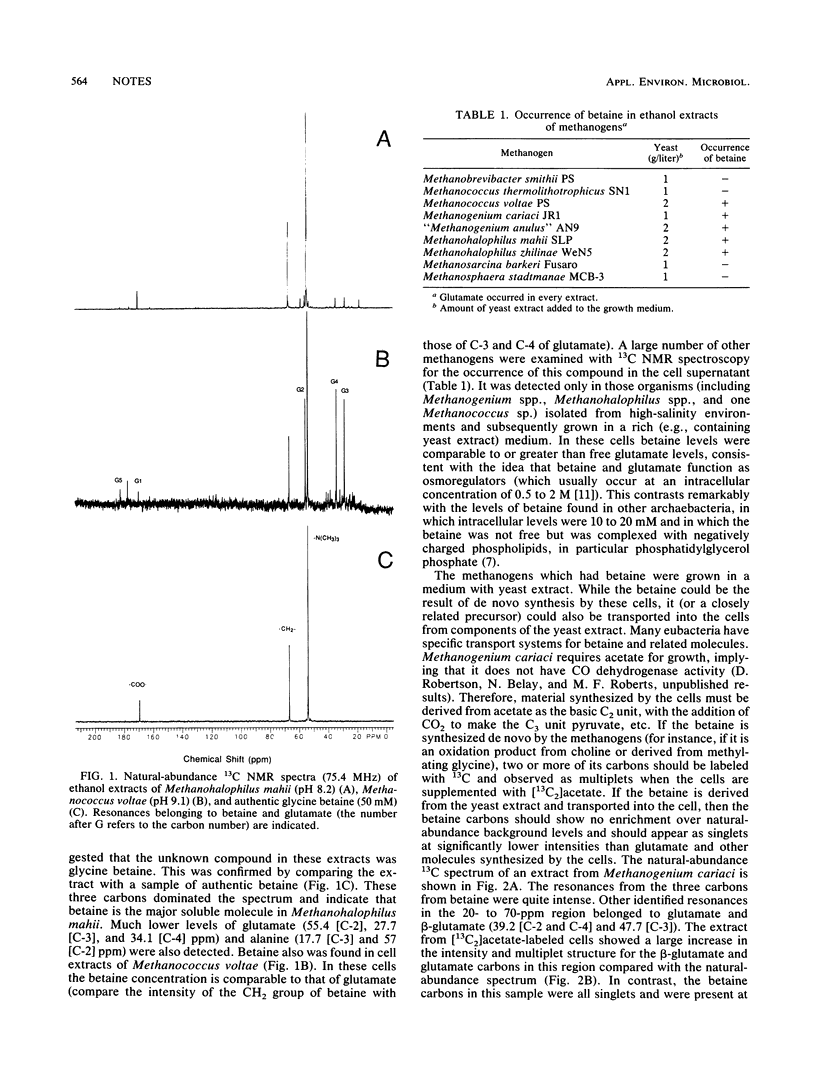Abstract
Trimethyl glycine (glycine betaine) was detected by 13C nuclear magnetic resonance spectroscopy at high intracellular concentrations in several methanogens (Methanogenium cariaci, "Methanogenium anulus" AN9, Methanohalophilus zhilinae, Methanohalophilus mahii, and Methanococcus voltae) grown on marine media containing yeast extract. 13C labeling studies with Methanogenium cariaci suggested that the betaine which accumulated inside the cells was not synthesized de novo but was transported in from the medium. Proof of such a transport system was provided by growing Methanogenium cariaci on yeast-free medium supplemented with betaine. Under these conditions, betaine was the dominant osmoregulator.
Full text
PDF


Selected References
These references are in PubMed. This may not be the complete list of references from this article.
- Boone D. R., Johnson R. L., Liu Y. Diffusion of the Interspecies Electron Carriers H(2) and Formate in Methanogenic Ecosystems and Its Implications in the Measurement of K(m) for H(2) or Formate Uptake. Appl Environ Microbiol. 1989 Jul;55(7):1735–1741. doi: 10.1128/aem.55.7.1735-1741.1989. [DOI] [PMC free article] [PubMed] [Google Scholar]
- Borowitzka L. J., Demmerle S., Mackay M. A., Norton R. S. Carbon-13 nuclear magnetic resonance study of osmoregulation in a blue-green alga. Science. 1980 Nov 7;210(4470):650–651. doi: 10.1126/science.210.4470.650. [DOI] [PubMed] [Google Scholar]
- Daniels L., Belay N., Rajagopal B. S. Assimilatory reduction of sulfate and sulfite by methanogenic bacteria. Appl Environ Microbiol. 1986 Apr;51(4):703–709. doi: 10.1128/aem.51.4.703-709.1986. [DOI] [PMC free article] [PubMed] [Google Scholar]
- Robertson D. E., Lesage S., Roberts M. F. Beta-aminoglutaric acid is a major soluble component of Methanococcus thermolithotrophicus. Biochim Biophys Acta. 1989 Sep 15;992(3):320–326. doi: 10.1016/0304-4165(89)90091-3. [DOI] [PubMed] [Google Scholar]
- Vreeland R. H. Mechanisms of halotolerance in microorganisms. Crit Rev Microbiol. 1987;14(4):311–356. doi: 10.3109/10408418709104443. [DOI] [PubMed] [Google Scholar]
- WOLIN E. A., WOLIN M. J., WOLFE R. S. FORMATION OF METHANE BY BACTERIAL EXTRACTS. J Biol Chem. 1963 Aug;238:2882–2886. [PubMed] [Google Scholar]


